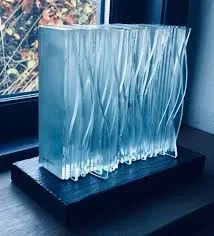Tempered glass, also known as toughened glass, is a type of safety glass that has been treated with heat or chemicals to increase its strength and thermal resistance. It is made by heating standard glass to a temperature of approximately 620 degrees Celsius (1,148 degrees Fahrenheit) and then rapidly cooling it. This process alters the physical properties of the glass, making it much stronger than regular glass. Due to its exceptional durability and safety features, tempered glass is widely used in various applications, ranging from construction to automotive industries.
One of the most significant advantages of tempered glass sheets is their strength. The tempering process creates a glass that is four to five times stronger than standard glass of the same thickness. This makes it an ideal choice for applications where safety and durability are essential, such as in shower doors, glass doors, and facades of buildings. If broken, tempered glass shatters into small, blunt pieces that are less likely to cause injury compared to sharp shards of untreated glass, making it a preferred material for environments where safety is a priority.
Another notable feature of tempered glass is its ability to withstand high temperatures and thermal shock. It can endure significant temperature fluctuations without cracking or breaking. This property makes tempered glass suitable for use in environments with extreme temperatures, such as in kitchen appliances, like oven doors, and in commercial buildings where glass facades are exposed to sunlight and heat. Its thermal resistance also allows it to be used in applications where heating and cooling are constant and extreme.
tempered glass sheet
In terms of aesthetics, tempered glass sheets present a sleek and modern look, making them a favored choice in contemporary architecture and interior design
. Its clarity and ability to allow natural light into spaces without compromising safety make it an attractive option for residential and commercial buildings alike. Furthermore, tempered glass can be coated or laminated in various finishes, providing additional design flexibility to architects and designers.
Despite its many advantages, tempered glass does have some limitations. It is generally more expensive than untreated glass due to the manufacturing process involved. Additionally, while it is resistant to breakage, it is not completely unbreakable. Significant force or impact can still cause it to shatter, albeit in a safer manner. This limitation necessitates careful consideration when selecting materials for specific applications.
In conclusion, tempered glass sheets offer a range of beneficial properties, including superior strength, thermal resistance, and aesthetic appeal. Its applications are vast, making it an essential material in modern construction and design. As safety and durability continue to be paramount in building practices, tempered glass will undoubtedly remain a popular choice for architects, builders, and homeowners alike. Its ability to blend functionality with beauty makes it a remarkable material that enhances both the safety and aesthetics of our environments.
 Afrikaans
Afrikaans  Albanian
Albanian  Amharic
Amharic  Arabic
Arabic  Armenian
Armenian  Azerbaijani
Azerbaijani  Basque
Basque  Belarusian
Belarusian  Bengali
Bengali  Bosnian
Bosnian  Bulgarian
Bulgarian  Catalan
Catalan  Cebuano
Cebuano  Corsican
Corsican  Croatian
Croatian  Czech
Czech  Danish
Danish  Dutch
Dutch  English
English  Esperanto
Esperanto  Estonian
Estonian  Finnish
Finnish  French
French  Frisian
Frisian  Galician
Galician  Georgian
Georgian  German
German  Greek
Greek  Gujarati
Gujarati  Haitian Creole
Haitian Creole  hausa
hausa  hawaiian
hawaiian  Hebrew
Hebrew  Hindi
Hindi  Miao
Miao  Hungarian
Hungarian  Icelandic
Icelandic  igbo
igbo  Indonesian
Indonesian  irish
irish  Italian
Italian  Japanese
Japanese  Javanese
Javanese  Kannada
Kannada  kazakh
kazakh  Khmer
Khmer  Rwandese
Rwandese  Korean
Korean  Kurdish
Kurdish  Kyrgyz
Kyrgyz  Lao
Lao  Latin
Latin  Latvian
Latvian  Lithuanian
Lithuanian  Luxembourgish
Luxembourgish  Macedonian
Macedonian  Malgashi
Malgashi  Malay
Malay  Malayalam
Malayalam  Maltese
Maltese  Maori
Maori  Marathi
Marathi  Mongolian
Mongolian  Myanmar
Myanmar  Nepali
Nepali  Norwegian
Norwegian  Norwegian
Norwegian  Occitan
Occitan  Pashto
Pashto  Persian
Persian  Polish
Polish  Portuguese
Portuguese  Punjabi
Punjabi  Romanian
Romanian  Russian
Russian  Samoan
Samoan  Scottish Gaelic
Scottish Gaelic  Serbian
Serbian  Sesotho
Sesotho  Shona
Shona  Sindhi
Sindhi  Sinhala
Sinhala  Slovak
Slovak  Slovenian
Slovenian  Somali
Somali  Spanish
Spanish  Sundanese
Sundanese  Swahili
Swahili  Swedish
Swedish  Tagalog
Tagalog  Tajik
Tajik  Tamil
Tamil  Tatar
Tatar  Telugu
Telugu  Thai
Thai  Turkish
Turkish  Turkmen
Turkmen  Ukrainian
Ukrainian  Urdu
Urdu  Uighur
Uighur  Uzbek
Uzbek  Vietnamese
Vietnamese  Welsh
Welsh  Bantu
Bantu  Yiddish
Yiddish  Yoruba
Yoruba  Zulu
Zulu 

